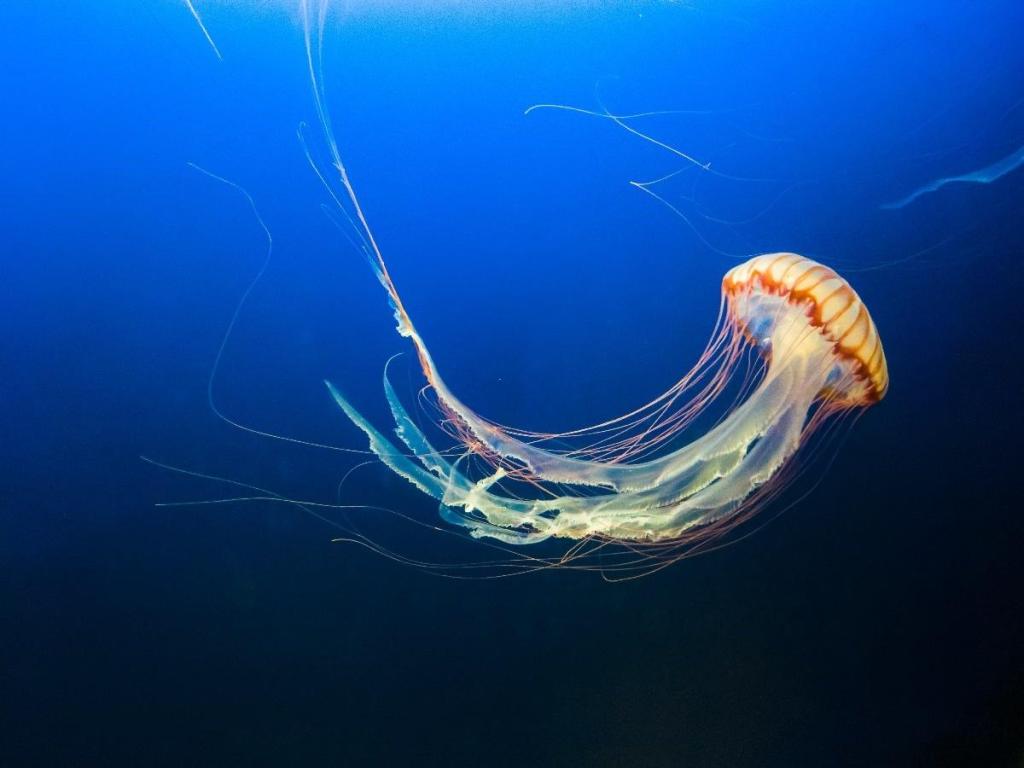According to scientists, jellyfish have lived on Earth for 500–700 million years, long before dinosaurs. These ape-like yet fascinating creatures have evolved to live in the depths of seas from the Arctic to the tropics, in sunlit shallow marshes and the depths of never-ending darkness.
Even in space, jellyfish have been used to assist researchers in understanding how humans will adjust to a difference in gravity. Jellies and people use calcium crystals to help them find their way around.
Because the life cycle of the jellyfish is so much shorter and its physiology is more straightforward, we gain a more coherent understanding of how space affects life.
Table of Contents
Are Jellies Fish?

The name is deceptive; they are not fish. Invertebrates, or creatures without symmetry oriented along the backbone, include jellyfish and medusas.
The vast variability within the jellyfish species makes it difficult to classify them using a simple taxonomy. The term a sort of gelatinous zooplankton is occasionally used to describe them.
Are Jellyfish Eyeless?

Most jellyfish hunt their food without using eyes or brains; instead, they float through the water invisibly until the prey collides with their tentacles. However, certain jellyfish can recognize visual cues.
The box jellyfish possesses the most sophisticated optical signal sensing apparatus of any currently recognized organism, with six different types of eyes making up a total of 24.
Even while our knowledge of these species’ visual capacities is still far from comprehensive, box jellyfish appear to have a 360-degree perspective of their surroundings.
Those eyes don’t seem capable of seeing images like human eyes. However, since two of them have corneas, lenses, and retinas and are very sensitive to light distinction, it seems likely that at least some kind of picture is created.
The other two varieties seem more adept at quick reactions, swimming navigation, and obstacle avoidance. At least one set of their eyes is usually pointed upwards, and they are grouped into four rhopalia structures at the base of its bell.
Do Jellyfish Pose a Risk?

Jellyfish do not intend to harm anyone. Most of our interactions occur when we unintentionally or curiously touch someone.
Some species must be viewed from a great distance; the 30-meter-long tentacles of the man-of-war, for instance, are hardly perceptible in the water. Many species have unbearably unpleasant stings.
Some of them may kill a person or an animal with their poison. Another risk is an allergic response. Because jellyfish aren’t precisely the quickest swimmers, they rely on their sting to knock their victims unconscious and immobilize them.
Nematocysts, a special kind of harpoon cell found in jellyfish, can be thought of as small capsules containing a poison. Millions of nematocysts shoot out from a jellyfish tentacle, pierce an object’s skin, and inject venom.
What Is the Name of a Group of Jellyfish?

The search returns articles referring to a certain kind of jellyfish as smack, but we verified and found that no scientists ever used this name. So that is probably a copy-paste. A cluster of jellyfish is frequently referred to as a bloom or swarm in scientific literature.
The phrase swarm typically connotes a propensity to stick together, such as, for instance, clusters of Moon jellyfish.
Bloom can relate to figures that are higher than expected, seasonal numerical increases, or local occurrences of enormous numbers of jellies. Due to the nature of their life cycles, jellyfish can bloom when the plankton supply rises.
Are Jellyfish Safe to Eat?

You risk getting stung if you try to grab a jellyfish out of the water. Additionally, avoid attempting to consume any jellyfish that has washed up on the coast since they disintegrate quickly and you risk contracting a terrible bacterial illness.
Jellyfish, though, could become an important food source, particularly regarding sustainability. They appear to adapt well to the increasing acidity of the ocean water, in contrast to all other animals that suffer. Additionally, their populations are far more challenging to exhaust than fish.
The most popular edible jellyfish species in China, Japan, and Korea are Rhopilema esculentum and Rhopilema his podium.
Other edible jellyfish species include Acromitus maculosus, Catostylus tagi, and Nomura’s jellyfish (which tends to bloom so that it can be a very plentiful source), Cannonball jellyfish (live cannonball jellyfish contain toxins that can cause cardiac problems in animals!), Jelly blubber,
In several Asian and Southeast Asian nations, edible jellyfish are deliberately fished out and marketed as seafood. Jellyfish salad is a typical dish on various Asian airlines.
The flavor is claimed to have a delicate, chewy texture and a somewhat salty flavor that occasionally is compared to the oyster flavor. Most of what is produced there is a salty, dried product that must be rehydrated before eating. Typically, the bell is the component consumed.
Vanilla and Nomura’s jellyfish are both ingredients in an ice cream made by a Japanese firm. Furthermore, jellyfish chips can be made in a crispy form.
Is Keeping A Pet Jellyfish Fun?

Jellies are peaceful pets. What do they do for a living? It floats. They seem lovely. They eat. That’s it. The most common pets are moon jellyfish, which, with proper care, may live for many months to a year. In general, jellyfish are extremely sensitive and incredibly vulnerable to harm.
The salt concentration and ph of jellyfish water must be preserved since freshwater jellyfish cannot survive. The nitrogen cycle and a certain ammonia level are required in the water.
Usually, you would create small brine shrimp for the jellies to consume, so you will need to be careful about what and how much you give them.
While the cost of a jellyfish itself is pretty low, starting at $25 for a widespread species, the price of the equipment is high. For jelly storage, a specific tank with rounded sides is required to prevent harm or entanglement of the gelatinous floaters.
For the jellyfish to be able to swim, the tank must also maintain a consistent water flow; otherwise, they will hang out at the bottom. Most aquariums incorporate elements like led lights to make the jellyfish more apparent.
The cost of the tank varies with size but generally starts at approximately $300.
Why do box jellies require eyes even though most others do not?

In contrast to most other jellyfish, the box jellyfish reside in shallow mangrove wetlands where they must navigate several hazards. It must be able to tell the difference between their pray, roots, and leaves because it also hunts throughout the day.
The results of an experiment further supported the theory that these jellyfish favor the waters near trees. They recognize it and try to return if they are carried from the shaded waters into the open ones.
Additionally, they have a mating technique that is relatively uncommon for jellyfish and involves precision rather than merely the discharge of the reproductive cells.
Does a Jellyfish Have a Pet?

Some jellyfish do create symbiotic relationships with other species, albeit they are not pets. The “upside-down jellyfish” known as Cassiopeia is typically found in shallow seas in warmer coastal parts of the world.
The photosynthetic algae that live in the medusa’s tentacles are symbiotic with one another. They optimize the tentacles’ exposure to sunlight, which the algae require to be productive, by resting upside-down on the bottom.
It almost seems like the jellyfish has its fertilizer farm. Small prawns are frequently welcomed by the upside-down jellyfish, which provides them with a haven in exchange for ridding it of parasites.
Other species work together with tiny fish that reside amid the tentacles and have immunity. Small fish can eat the leftover fish that the jellyfish has caught while protecting themselves from any predators.
They can also serve as bait to entice larger fish into the trap. For instance, eleven distinct fish species may coexist with the cannonball jellyfish.
Are Jellyfish Intelligent or Emotional?

As we understand them, jellyfish don’t have a heart or a brain, and they also don’t have blood that has to be pumped. Since they are 98 percent water, oxygen may diffuse straight into their thin, gelatinous bodies.
Jellies have a straightforward neurological system, albeit it can range in complexity from a primary surface nerve network to more intricate structures known as rhopalia (box jellyfish).